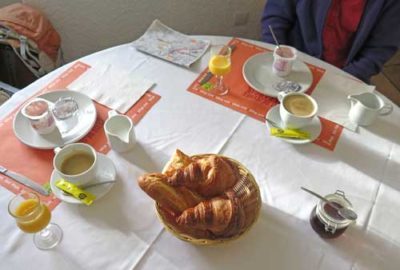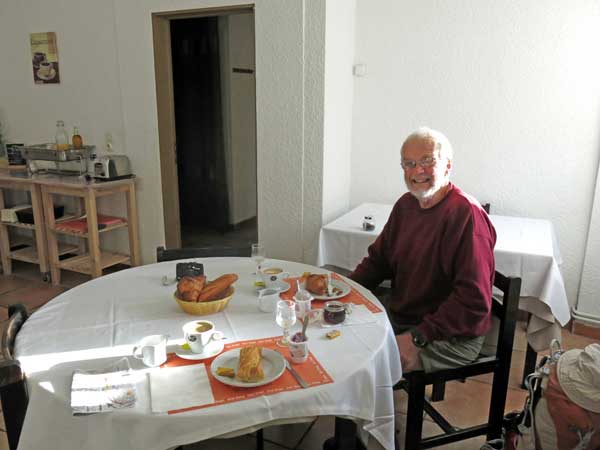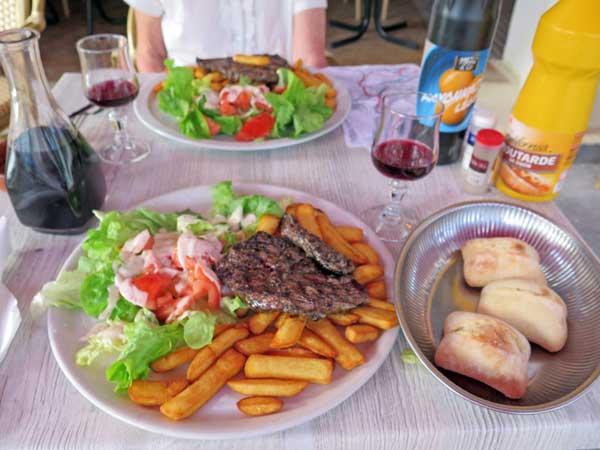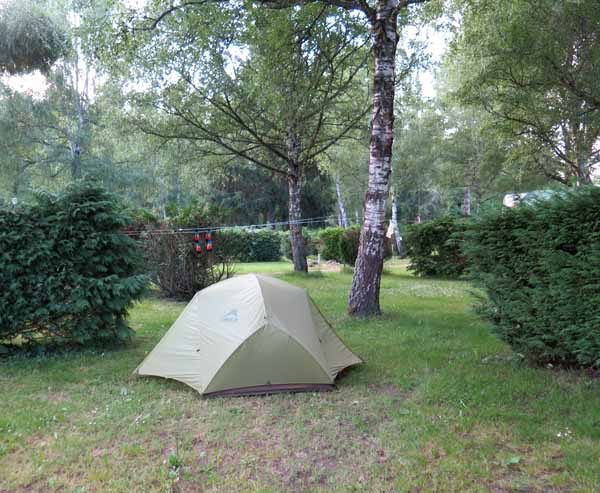Tuesday, 18 June 2019
Distance 23 km
Duration 5 hours 50 minutes
Ascent 431 m, descent 603 m
At 7 am, dressed and packed, we left the silent camping ground, walked back down the long avenue to the main road and presented ourselves at the hotel, where two tables were set for breakfast, making us wonder whether only one couple had stayed there last night.
The establishment looked to be flourishing, but perhaps they were surviving on lunches and dinners.

The sun slanted in through the street window, promising a pleasant day’s walking after the rain and cold that we had endured recently.

Arranged on the snowy folds of the tablecloth were orange juice, yoghurt, and a basket of croissants and bread, with which we had two rounds of coffee.
Both the croissants and the bread were beautifully crusty and light, and we made generous use of the butter and jam.
Setting off in earnest, we retraced our steps down the road to the Super U, past shops and bars that were all closed at this hour.
Then we walked about a kilometre along the highway (the D19) and branched off on a minor road that quickly became a path through a meadow, flanked by a deciduous wood.
Everything around us was intensely green and fresh.
Before long we entered a pine forest and started to go downhill.
The path was now a forestry track and we soon came to a place where workers with front-end loaders were stacking huge teetering piles of logs on the upper side of the track.
They did not look very stable (the logs, not the workmen), so we were glad when we were safely past them.
Here a sign pointed down into the dense forest, to an ancient charterhouse, but we continued along the main track and never even caught a glimpse of it.
At the bottom of the track we joined a bitumen road and crossed the Sioule again, which was a surprise because we thought we had seen the last of it in Châteauneuf-les-Bains.

Then we immediately took a steeply rising, muddy track which crossed the zig-zagging car road several times on its way to the top, where the quiet little village of St-Jacques-d’Ambur was perched.
We were now on the marked GR4, which we had joined just after the bridge over the Sioule.

Beyond the village we began to descend again, on a gravelly old forestry track that wasted no time getting to the artificial lake at the bottom, which was a large spread of water held back by a barrage over the Sioule.
It was an expansive, peaceful scene, with the water reflecting the green hills that crowded its edges, and little boats moored here and there.
Having joined a small tar road, we then came to a new-looking building proclaiming itself a bistrot.

The terrace was crammed with tables, but there were no chairs and no people, and a sign informed us that it would open for the season on the 24th of June – that is to say, next week.
We made the best of it by sitting on one of the tables and having some dried fruit and water.
It was 11 am and we were not tired yet, nor unduly hungry after our substantial hotel breakfast.

Beyond the bistrot we kept to the road, while the GR performed some pointless plunges and climbs in order to keep off the bitumen, and we felt vindicated when only a few cars went past in the two or three kilometres until the GR rejoined us.
Then we crossed a bridge and curved around in thick woodland until we came to a second bridge, this one over the Sioulet, the main tributary of the Sioule.
Immediately after that we came to the village of Miremont, where we hoped to have coffee at the bar, but to our horror the bar was closed, and in fact the place looked like a ghost town, with not a soul in sight.
The odd thing was that, although there were no living beings in sight, there were numerous convincing life-sized models of people from a bygone age – a long-skirted woman in a field with ducks and geese around her feet, a pony and trap carrying a bonneted woman and a man in his Sunday best, a group of peasants in smocks resting outside a doorway.

We walked a few steps around the corner, and came to a little shop with some real people in it, as well as more models – a uniformed postman with his bicycle (was he Jacques Tati?), a stout matron pushing a wicker pram, and a fisherman leaning against a tree.
The little supermarket was about to close (it was 12:30), but we managed to get two cold cans of Orangina, which we drank sitting on a low wall nearby.

They were delicious and we cheered up remarkably. Keith also did a few foot repairs to ward off threatening blisters.
Leaving Miremont, we turned off just past the shop, crossed a stream and entered a shockingly steep forest, where we proceeded to gain a hundred metres of altitude in almost the same distance.
We had not done anything this strenuous for a long time, but the track was wide and there were shady trees overhead.
Before we could start complaining we were at the top, out in the sunny fields, and descending gently along a ridge towards our destination, the town of Pontaumur.
This dirt track went along easily enough, but the big climb had made us more tired than we realised, and we soon began to fade in the hot sun.
After a couple of kilometres we joined a bigger road, went past a handsome old brick chimney, and started to plunge into the valley.
When we merged with the D987, our troubles magnified, as it was a road lined with crash barriers, with white lines marking the centre and sides (always a bad sign).
However we had no great difficulty until we crossed the first bridge, at which point we unwisely took a little side road that, according to our map, would avoid the highway. This climbed steeply and wended past some houses before coming to an indecisive end in a patch of nettles. We had no choice but to go back to the main road and resume our trudging, even tireder and crosser than before. I had blisters on four toes and was not in a good mood.
The entry to the town, although drab and dreary in the near view, was dominated by the great white cathedral, as long as an ocean liner, floating serenely by itself on a high hill.
Almost at its foot we turned into the main shopping street and immediately saw a bar, where we sank down for our first coffee since setting off this morning.
Next to this bar was a restaurant, where people were still lunching although it was after 2 pm. It would be open this evening, said the waiter, which was a great relief, as we did not feel like having yet another picnic.
On the other hand, it seemed a fairly humble place, offering only grills and salads, so on our way to the camping ground (about half a kilometre away) we looked around for other restaurants, but failed to find any.

For some reason this side of the village seemed to be in a frenzy of construction, with cranes, trucks, barriers and noise all along the main road, right up to the entrance of the camping.
However the place itself was pleasantly bucolic and grassy. The plots were shaded by handsome silver birches and separated by hedges – useful for attaching our clotheslines, or at the very least for draping our washing over.
There were many other campers there, and the river Sioulet flowed past at the far end.
After a reviving wash and a sleep on our mats in the shade, we took ourselves back to town for dinner.

Although we had been doubtful about the merits of the one and only restaurant, it turned out to be very enjoyable.
The food was of the simplest – steak, chips and salad – but with bread and wine and the murmur of other diners nearby, it was quite delightful. One of our fellow diners took a photo of us looking very pleased with ourselves.
At the bar next door we found out that it opened at the very satisfactory hour of 7 am, and that there was a boulangerie in the side street nearby, so we strolled back to our tent feeling that we had done well.
Previous day: Châteauneuf-les-Bains to St-Georges-de-Mons





